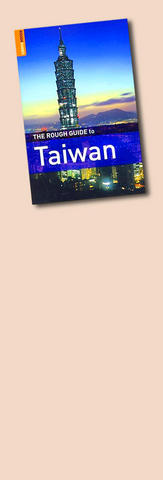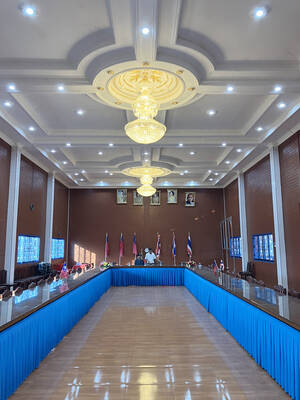This is an outstanding guidebook. It's the finest guide to Taiwan ever likely to be produced simply because it's hard to see how the job could possibly be done any better.
All guidebooks represent a selection of possible material. I confess to having written two myself, and co-written a third, but I freely admit that The Rough Guide to Taiwan is almost infinitely superior to any of the guidebooks I was responsible for. It's a model of how such things should be done, and Taiwan is blessed indeed to be the recipient of these two authors' meticulous and wide-ranging labors.
The book has many different virtues. It's accurate, detailed, enthusiastic and eloquent. It doesn't pull its punches when it finds somewhere of little interest (Taoyuan, for instance, is "wholly unattractive"). But by and large it finds Taiwan enormously alluring, the people "unquestionably some of the friendliest in Asia," and the whole island the region's "most underrated tourist destination."

First and foremost, the book is marked by its practicality and accuracy, making it supremely useful when out on the ground wondering when the next bus leaves, as well as when looking for the bus-station itself. But second, it's very remarkable for its avoidance of cliche. So much travel writing these days is gush, but this guidebook is extraordinarily fresh in tone. There are, admittedly, a few "soaring" cliffs, "timeless" lifestyles and (horror of horrors) "bustling" cities, but these hackneyed adjectives are almost invariably in the small number of summary pages that precede each section, and were probably penned by the book's editors.
Stephen Keeling and Brice Minnigh actually display a refreshing individuality, reflected in their style. This is particularly the case when it comes to describing Taiwan's mountains - Minnigh's special responsibility, apparently. Thus Yushan (玉山) is "benignly indifferent" to the heavily populated lowlands, and its high-altitude Badongguan (八通關) meadows "dreamlike." Nanhushan (南湖大山) is "gorgeous," the road that skirts Hehuanshan (合歡山) "stupefying," the views along the Caoling Trail (草林古道) "mesmerizing," the ascent of Hsuehshan (雪山) a "grandiose gateway" to what is to come. The Guanwu Recreation Area leading to Dabajianshan (大霸尖山) contains "humbling" old-growth forests, and the Shei-Pa National Park (雪霸國家公園) is "unapologetically rugged." At Lishan's (梨山) Swallow Castle Resort and Hotel "the splendid mountains views from the windows are more than enough to divert your attention form the tacky decor."
It's also presumably Minnigh who wrote the first-rate sections on access to the high mountains, citing "the astounding level of misinformation regarding Class A mountain permits." Early on he leads readers through the application process, and later excels himself by going out of his way to explain how such permits can be obtained within the hour. You get the impression that there's nothing he'd love to achieve more with this book than attract first-timer hikers to these astonishing heights.
The authors are invariably frank, but also just. Hualien's train-station area is "a bit dead," public transport to its harbor "a pain," and the city's night-life "fairly subdued." The nearby Liyu Lake is "only worthwhile if you have lots of time." Kaohsiung, however, has a "palpably laid-back feel," and the authors have some welcome words in praise of Hsinchu's historic Beimen Street (北門街), somewhere I've always liked but which is either wholly neglected or actually damned as being without interest in some competing publications. Lugang's appeal, by contrast, "tends to be exaggerated."
The book is surprisingly up-to-date, too, just managing to record that the High Speed Rail system is up and running at the end of a paragraph that refers to its imminent operation, plus the effect it will have on the nation, in the future tense. It's also very intelligently written, making it rare among guidebooks. The authors can observe, for example, that Taiwan's national parks' strict conservationist laws "are at stark odds with time-honored Aboriginal hunting practices," while remaining pro-conservation in their general tenor.
They can also be ironic without being condescending. The Spring Scream festival is an occasion for "unbridled indulgence," and the officials on the island of Nangan (南竿) have thought fit to render the Chinese slogan "Sleep with one's sword ready" into English with the more anodyne "Always on the alert." But no one is blamed, simply smilingly indulged.
The numerous Internet links throughout the book are also a major plus. Other plusses are the inclusion of Chinese characters relevant to what's being discussed in convenient boxes alongside the text, and accurate and up-to-date information on prices in general, plus train, bus and flight times. There's also a mass of detailed background material, on subjects ranging from the Landlocked Formosan Salmon at Wuling Farm (武陵農場) to Hou Hsiao-hsien's (侯孝賢) 1987 movie City of Sadness (悲情城市), and the fact that there were at least 15 Japanese POW camps in Taiwan during World War II, as background to Jiufen (九份) and Jinguashi (金瓜石).
There's little doubt that these two writers must have felt as jaded as the rest of us when revisiting well-known sites such as Yangmingshan or Taroko Gorge. But they still manage to describe them, and how to get there, with accuracy and enthusiasm.
They also have a good word for Taiwan's media, described as exhibiting "a level of openness that is almost unheard of in Asia's other Chinese societies, including Hong Kong and Singapore." The authors are both journalists, so the praise is understandable. But they're also writers who clearly love Taiwan, and it shows.
This guidebook won't only be a godsend to visitors to Taiwan from abroad - it should also be an essential possession for all English-speaking Taiwan residents. If it only leads you to catch one long-distance bus on time, or to climb one high mountain you'd never have considered before, it will have been money well-spent. But the reality is it will do a very great deal more as well.

Taiwan Power Co (Taipower, 台電) and the New Taipei City Government in May last year agreed to allow the activation of a spent fuel storage facility for the Jinshan Nuclear Power Plant in Shihmen District (石門). The deal ended eleven years of legal wrangling. According to the Taipower announcement, the city government engaged in repeated delays, failing to approve water and soil conservation plans. Taipower said at the time that plans for another dry storage facility for the Guosheng Nuclear Power Plant in New Taipei City’s Wanli District (萬里) remained stuck in legal limbo. Later that year an agreement was reached

What does the Taiwan People’s Party (TPP) in the Huang Kuo-chang (黃國昌) era stand for? What sets it apart from their allies, the Chinese Nationalist Party (KMT)? With some shifts in tone and emphasis, the KMT’s stances have not changed significantly since the late 2000s and the era of former president Ma Ying-jeou (馬英九). The Democratic Progressive Party’s (DPP) current platform formed in the mid-2010s under the guidance of Tsai Ing-wen (蔡英文), and current President William Lai (賴清德) campaigned on continuity. Though their ideological stances may be a bit stale, they have the advantage of being broadly understood by the voters.

In a high-rise office building in Taipei’s government district, the primary agency for maintaining links to Thailand’s 108 Yunnan villages — which are home to a population of around 200,000 descendants of the Chinese Nationalist Party (KMT) armies stranded in Thailand following the Chinese Civil War — is the Overseas Community Affairs Council (OCAC). Established in China in 1926, the OCAC was born of a mandate to support Chinese education, culture and economic development in far flung Chinese diaspora communities, which, especially in southeast Asia, had underwritten the military insurgencies against the Qing Dynasty that led to the founding of

It’s fairly well established that strength training is helpful at every age: as well as building muscle, it strengthens tendons and ligaments, increases bone density and seems to have protective effects against everything from osteoporosis to dementia. But a new study based on data collected over two decades in Rio de Janeiro, Brazil, suggests that another physical attribute might be just as important — and it’s one that declines even faster than strength as the years go by. The good news? It might also be less uncomfortable, and even slightly safer, to improve. Also, it will probably make you better